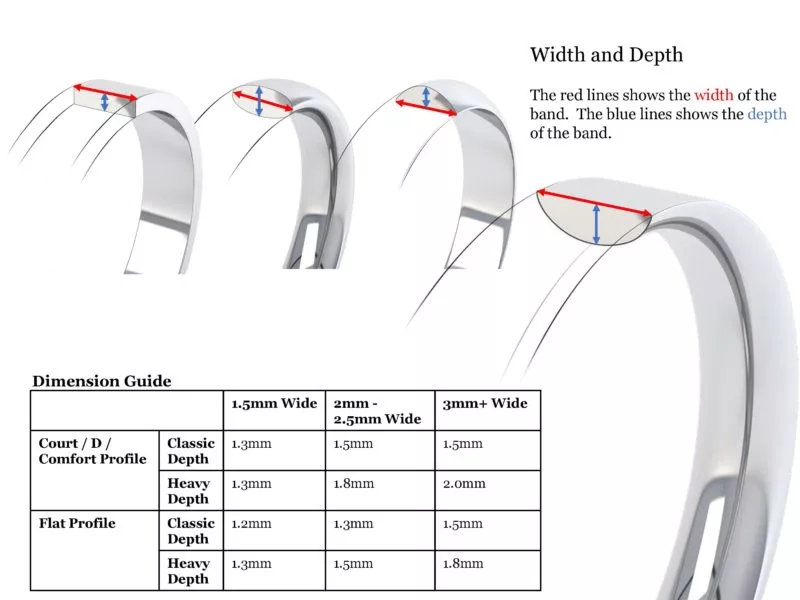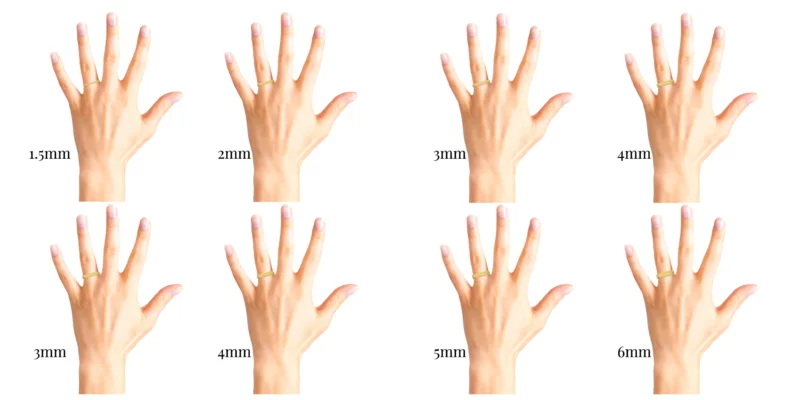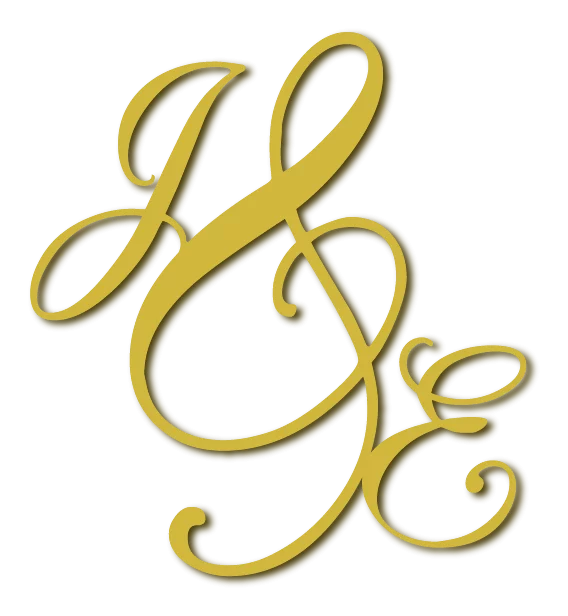How to choose a wedding ring

 Choosing your wedding ring can be a daunting task. At Jacqueline & Edward we have a large and ever-growing range of ethical handmade wedding rings which as one customer succinctly surmised, can cause “analysis paralysis”.
Choosing your wedding ring can be a daunting task. At Jacqueline & Edward we have a large and ever-growing range of ethical handmade wedding rings which as one customer succinctly surmised, can cause “analysis paralysis”.
Choice allows you to feel individual and connect with a design you like. It also inspires some people to develop ideas for new bespoke ring designs which they would not otherwise have thought of and perhaps want to have created by us. However, whilst variety is the spice of life, we also totally understand the challenges it brings and the need to manage the decision-making process.
In response to these challenges, we believe that choosing a wedding ring can be broken down into 4 main steps because there are ultimately 4 different elements to a wedding ring design. These comprise
- Profile
- Dimensions
- Finish
- Metal type
We’ve covered each in more detail below.
This information sheet explores each of these elements and applies them to the Jacqueline & Edward wedding ring collection and product options to make your journey more productive and enjoyable and hopefully diffuse a serious case of analysis paralysis.
Don’t forget, we can make any style of ring in any profile or dimension, so if you can’t see what you love on our website, that won’t stop us helping you find, and then make; your perfect wedding ring.
Step 1 - Profile
 The profile of a ring is the cross-sectional shape. In other words, if you imagine cutting the ring off with a jewellers saw, then it is the shape you can see in the newly cut side of the metal. It is important because it defines the rings basic form and influences the way the ring feels on your finger, behaves over time and looks whilst being worn.
The profile of a ring is the cross-sectional shape. In other words, if you imagine cutting the ring off with a jewellers saw, then it is the shape you can see in the newly cut side of the metal. It is important because it defines the rings basic form and influences the way the ring feels on your finger, behaves over time and looks whilst being worn.
In terms of feel, we would order the rings from most comfortable to least comfortable as follows: Court, D-profile, Flat Profile and comfort profile.
But, everyone is different and this is just our experience. Depth, discussed under dimensions, can also have a significant bearing on feel, often more so than profile. There are a number of standard profiles offered by Jacqueline & Edward, namely Court, Comfort (Flat Court), D-Profile and Flat Profile. All our ring styles can be made in any profile. More unusual profiles are possible e.g. double comfort and completely unique profiles are possible e.g. triangular, organic and hexagonal should you wish to get in touch. Here is an overview of the different profiles you’ll commonly see on the Jacqueline & Edward site:
COURT PROFILE: Court profile rings are curved on the outside and curved on the inside. Considered a very traditional profile, it is both elegant and super comfortable. We always say that this ring quickly feels a part of you and is an excellent choice for those who do not wear rings. We also find that the absence of any straight or sharp edges means this profile is less prone to catching on things and taking dings that affect form e.g. dings on the exposed edges of flat profile rings. Another point of note is that the upper surface of the band on a ladies engagement ring is often curved, making court profile a nice match from above for the majority of engagement ring styles. The Devon is an example of a court profile ring.
D PROFILE: D profile also provides a great match for the majority of engagement ring profiles due to it’s upper curved surface, however unlike the court profile Which is curved on the underside the D profile is flat on the underside. D-profile wedding rings are again a very traditional wedding ring shape. The Wanlock is an example of a D profile ring.
FLAT PROFILE: A flat profile ring is flat on the outside and flat on the inside with flat sides. Considered a contemporary profile, it has clean lines with defined but comfortable edges. Our opinion is that this profile is more prone to catching on edges than a court profile and also more prone to noticeable dings due to the angular edges. Due to the consistent depth of the ring across it’s width, it also tends to feel bulkier between your fingers, so heavier depths in flat profile are more noticeable and potentially less comfortable than heavier depths in court profile. The Brora is an example of a flat profile ring.
COMFORT PROFILE (FLAT COURT): A comfort profile ring is flat on the outside and curved in the inside. It has the benefit of the contemporary look from the outside by with the comfort and feel of the court profile on the inside. The Hadydarn ring is an example of a comfort profile ring. The Hadydarn is an example of a comfort fit ring.
Step 2 - Wedding Ring Dimensions
 There are two dimensions of importance whilst choosing your wedding ring aside of your size, which you can get assistance with here. These are width and depth
There are two dimensions of importance whilst choosing your wedding ring aside of your size, which you can get assistance with here. These are width and depth
discussed in further detail below:
WIDTH: How do you choose the width of your wedding ring? What is the typical size for a mens wedding ring? What is the typical width of a woman’s wedding ring? These are the usual questions we are asked in this area.
In our experience, over 85% of men choose 4mm or 5mm wide wedding bands, about 10% choose 3mm or 6mm and then there are the occasional rings made which are greater than 6mm. Normally wider wedding rings look more proportionate on larger hands or longer fingers.
Also, we find that about 85% of ladies choose narrow wedding rings, usually between 1.5mm and 2.5mm wide, with the most common width being 2mm in our experience. A 2mm wedding ring sits nicely with most engagement rings which most of the time have a band width of 2mm or just below. We often get asked whether you should choose a wider, similar or narrower wedding band to the engagement ring but this generally comes down to personal taste and what you think is aesthetically pleasing, albeit most of our ladies choose a wedding ring the same as or greater in width than the engagement ring band width.

DEPTH: We make our handmade wedding rings in two standard depths; classic and heavy. The depth of classic and heavy changes depending on the width of the ring chosen and the chart above shows the different depths relating to the two options across all the widths of wedding rings we supply. We are often asked whether a Client should choose heavy or classic and the answer is reasonably straightforward.
Classic Depth is chosen by approximately 90 % of all our customers with the exception of those who choose heavy depth or those who choose a bespoke depth based on the existing depth of their engagement ring so the two rings match. Our classic depth still has plenty of weight and is considered a heavy weight ring by some jewellers. They tend to feel less noticeable between the fingers and are great for everyday wear.
Heavy depth rings are the perfect choice for those who like heavier weight jewellery or are very physical and are therefore more likely to expose their ring to repeated bumps and scrapes. Heavy depth rings are more expensive than the classic depth rings, simply because we need more gold or platinum to create them.
Mark wears a court ring profile because it is practical and comfortable which is 4mm wide and heavy depth. The heavy depth ensures that the countless hours spent panning in the river moving boulders and panning for gold does not detrimentally affect it even after 13 years and counting.
Step 3 - Wedding Ring Finish

The finish of a ring is the texture or effect applied to the outside of the ring. Most finishes can be interchangeable with the exception of the hammered finishes which are difficult to modify into non-hammered finishes due to the impact hammering has on the actual contours of the ring. This reduces the possibility of recreating a smooth surface and profile atop which to apply an alternative finish without having to file back metal and loose depth from the ring, which is not ideal. As such, if you are considering changing the finish at any point in the rings lifetime, this is a worthwhile consideration.
Smooth finishes tend to lend themselves to a traditional look, whereas the hammered and textured finishes are considered more contemporary and can be synonymous with terms like organic. There is no right or wrong decision with regards to finish and the choice is purely about aesthetics. If you are unsure, you can always pick a polished finish and then revise your finish to any other at your Leisure. We tend to find that the finishes on a ring can be split into four general categories, discussed with examples below:
Muted smooth finishes: Muted finishes displace the light so as to minimise reflection. Matt and light frosted finishes are muted and create
Bright smooth finishes: Bright finishes reflect the light. A polished finish is the most traditional bright finish and represents approximately 70% of all rings made at Jacqueline and Edward. The Devon is an example of a polished finish. Etched and heavily frosted finishes are also bright finishes, but do not reflect the light like a polished finish, instead, they scatter the light and almost appear to “sparkle” in the light as the ring is moved around. The etched finish can be seen on the Lee ring.
Hammered finishes: Some of the hammered finishes are bright finishes and these are typically applied either with a polished hammer, or by using striking the ring with a ball punch. The surface of each facet is then polished further to create a glass-like surface such as can be seen on our Kinglass rings. More muted hammered finishes are created when the rings are struck with a textured hammer, this could a texture which has occurred naturally through years of use, such as the Barrs ring, or one which has been purposefully cut into the hammer such as the finish on the Mennock ring.
Textured finishes: Our textured finishes is created by working directly onto the surface of the metal, such as that seen on the Calders ring or the Spey ring.
For a special occasion such as a couples photoshoot, the finish on our Rings can always be refinished using our ring finishing service. Also, almost any finish can be applied to any ring, so do get in touch if your exact requirements are not met by our current range online.
Step 4 - Wedding Ring Metal
 There are a number of considerations when it comes to choosing the precious metal type. Jacqueline & Edwards typically work in 4 metals. The factors to consider are discussed below:
There are a number of considerations when it comes to choosing the precious metal type. Jacqueline & Edwards typically work in 4 metals. The factors to consider are discussed below:
Colour: The popularity of colour changes over time. White, yellow and rose have all had their moments in the spotlight as the flavour of the year so we always advise our clients to follow their own path. It is worth considering whether you wish to match up to an existing engagement ring, or to match other jewellery you often wear. Sometimes it is simply a case of preference.
What can impact colour is the use of family gold, which we love doing. If you provide a 9ct ring for inclusion in your wedding rings for example, there is an enrichment of copper, which when brought up to 18ct can leave the finished ring somewhat on the rosey side. We would recommend you open a discussion with us prior to using family gold if colour is of significant importance to you.
Durability and hardness: Platinum is the strongest and most durable of the metals we work in. Moving from strongest to weakest following platinum the order is rose gold – yellow gold – white gold. This might not be the same for all alloys, but certainly ours. All our rings can be created in any of the metals we work in and they are all suitable for everyday wear. It may be a consideration if you are particularly heavy-handed, or if you have a delicate engagement ring you wish to minimise wear against by marrying up to a similar strength of alloy in your wedding band.
It should also be noted, that much finer detail is possible on platinum because of its strength and also it is the most scratch-resistant, with palladium rich white gold being the least scratch resistant. That being said, these are all soft metals relative to titanium or such and therefore will all mark over time, albeit often the marks burnish back out through everyday wear.
Consideration could also be given in this area of decision making to the longevity of the finishes applied to the rings, with the softer metals more likely to mark / scratch / burnish which can, in turn, affect how long the finishes stay the same as the day they left the workshop.
Weight: Platinum is the heaviest metal we work in and is about 30% heavier than the same volume of 18ct yellow gold. Our rose gold and yellow gold is the same weight and then our white gold is the lightest owing to the high palladium content. Palladium is just over 60% the density of 24ct gold and our rings have a 16% palladium content resulting in a lighter metal than our rose gold, yellow gold or platinum.
Summary
Choosing your wedding ring at Jacqueline & Edward should be an enjoyable process. Splitting the decision down into the core elements of the ring is the way we work with people who visit the studio and are trying to find the right ring for them. This also prevents analysis paralysis and by the end of the step by step process most people have come to a conclusion on which ring to buy.
If you want further assistance on the decision making process, do not hesitate to “get in touch”, or if you are looking for something bespoke, perhaps take a look at our “bespoke page wedding rings page“.
Also, we have example finishes, widths and profiles which can be sent out to you to assist in your decision-making process if you are still stuck between a number of options.
All our ethical wedding rings are handmade, created in the UK from recycled metals and alluvial river gold. We pride ourselves on creating sustainable jewellery that doesn’t compromise the environment.


